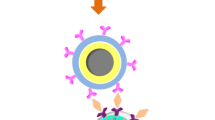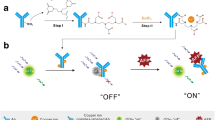Abstract
Cu2+ are found to greatly reduce the photoinduced oxidase activity of fluorescein and then inhibit the chromogenic reaction catalyzed by fluorescein. A simple colorimetric assay for Cu2+ is established. Based on this, bifunctional nanocomposites of α-fetoprotein (AFP) antibody (Ab) and copper-based metal-organic framework (Ab2@Cu-MOF) are synthesized by the simple self-assembly of AFP Ab2, Cu2+, and 4,4′-dipyridyl: the binding site of AFP Ab2 exposed on the surface of the nanocomposites can specifically recognize AFP antigen; Cu2+ in nanocomposites can inhibit the visible light-induced activity of fluorescein. The structure of Ab2@Cu-MOF disintegrate and Cu2+ is released in an acetate buffer solution. The higher the amount of AFP antigens, the more significant the inhibitory effect. Thus, the Ab2@Cu-MOF immunoassay for AFP determination is established using 3,3′,5,5′-tetramethylbenzidine as chromogenic substrate with a detection limit of 35 pg.mL−1. This simple, cheap, and sensitive method sheds substantial light on practical clinical diagnosis. Meanwhile, the mechanism of inhibition is revealed to facilitate the targeted selection of enzyme regulators.

Diagrammatic illustration of Cu2+ detection (part a) and Ab2@Cu-MOF immunoassay for sensing α-fetoprotein based on the synthesized Ab2@Cu-MOF nanocomposites (parts a and b).




Similar content being viewed by others
References
Luo P, Yin P, Hua R, Tan Y, Li Z, Qiu G, Chen W (2017) A large-scale, multi-center serum metabolite biomarkers identification study for the early detection of hepatocellular carcinoma. Hepatology 67:662–675
Pham NM, Mizoue T, Tanaka K, Tsuji I, Tamakoshi A, Matsuo K, Tsugane S (2013) Meat consumption and colorectal cancer risk: an evaluation based on a systematic review of epidemiologic evidence among the Japanese population. Jpn J Clin Oncol 43:935–941
Wu Y, Guo W, Peng W, Zhao Q (2017) Enhanced fluorescence ELISA based on HAT triggering fluorescence “turn-on” with enzyme-antibody dual labeled AuNP probes for ultrasensitive detection of AFP and HBsAg. ACS Appl Mater Interfaces 9:9369–9377
Wei H, Wang E (2013) Nanomaterials with enzyme-like characteristics (nanozymes): next-generation artificial enzymes. Chem Soc Rev 42:6060–6093
Zhang L, Fan C, Liu M, Liu F, Bian S, Du S (2018) Biominerized Gold-Hemin@MOF composites with peroxidase-like and gold catalysis activities: a high-throughput colorimetric immunoassay for alpha-fetoprotein in blood by ELISA and Gold-catalytic silver staining. Sensors Actuators B Chem 266:543–552
Chan CW (1998) Quantum dot bioconjugates for ultrasensitive nonisotopic detection. Science 281:2016–2018
Wang S, Deng W, Yang L, Tan Y, Xie Q, Yao S (2017) Copper-based metal-organic framework nanoparticles with peroxidase-like activity for sensitive colorimetric detection of Staphylococcus aureus. ACS Appl Mater Interfaces 9:24440–24445
Liao FS, Lo WS, Hsu YS, Wu CC, Wang SC, Shieh FK, Tsung CK (2017) Shielding against unfolding by embedding enzymes in metal-organic frameworks via a de novo approach. J Am Chem Soc 139:6530–6533
Hearfield DAH, Kilby BA (1958) Enzymes of the Tricarboxylic acid cycle and cytochrome oxidase in the fat body of the desert locust. Nature 181:546–547
Liu Y, Purich DL, Wu C, Wu Y, Chen T, Cui C, Wang Y (2015) Ionic functionalization of hydrophobic colloidal nanoparticles to form ionic nanoparticles with Enzymelike properties. J Am Chem Soc 137:14952–14958
Liu L, Sun CQ, Yang J, Shi Y, Long YJ, Zheng HZ (2018) Fluorescein as a visible-light-induced oxidase mimic for signal-amplified colorimetric assay of carboxylesterase by enzymatic cascade reaction. Chem Eur J 24:6148–6154
Hu Y, Cheng H, Zhao X, Wu J, Muhammad F, Lin S, Deng Y (2017) Surface-enhanced Raman scattering-active gold nanoparticles with enzyme mimicking activities for measuring glucose and lactate in living tissues. ACS Nano 11:5558–5566
Guascito MR, Malitesta C, Mazzotta E, Turco A (2008) Inhibitive determination of metal ions by an amperometric glucose oxidase biosensor : study of the effect of hydrogen peroxide decomposition. Sensors Actuators B Chem 131:394–402
Fujita T, Sakuma S, Fujimoto K, Yoshioka K, Ashida E, Nishida H, Fujimoto Y (1995) Effects of fatty acids and fatty acyl CoA esters on Cu2+ −induced conversion of xanthine dehydrogenase to oxidase in rabbit liver. Free Radic Biol Med 19:487–491
Brewer GJ (2009) The risks of copper toxicity contributing to cognitive decline in the aging population and to Alzheimer's disease. J Am Coll Nutr 28:238–242
Wang C, Gao J, Tan H (2018) Integrated antibody with catalytic metal-organic framework for colorimetric immunoassay. ACS Appl Mater Interfaces 10:25113–25120
Buss H, Chan TP, Sluis KB, Domigan NM, Winterbourn CC (1997) Protein carbonyl measurement by a sensitive ELISA method. Free Radic Biol Med 23:361–366
Zhang S, Yu T, Sun MT (2014) Highly sensitive and selective fluorescence detection of copper(II) ion based on multi-ligand metal chelation. Talanta 126:185–190
Yang W, Shi X, Shi Y, Yao D, Chen S, Zhou X, Zhang B (2018) Beyond the roles in biomimetic chemistry: an insight into the intrinsic catalytic activity of an enzyme for tumor-selective phototheranostics. ACS Nano 12:12169–12180
Tian ZM, Li J, Zhang ZY (2015) Highly sensitive and robust peroxidase-like activity of porous nanorods of ceria and their application for breast cancer detection. Biomaterials 59:116–124
Huang H, Liu L, Zhang L, Zhao Q, Zhou Y, Yuan S, Tang Z (2017) Peroxidase-like activity of ethylene diamine tetraacetic acid and its application for ultrasensitive detection of tumor biomarkers and circular tumor cells. Ethylenediaminetetraacetic Acid 89:666–672
Lin LP, Song XH, Chen YY, Rong MC, Zhao TT, Wang YR, Jiang YQ, Chen X (2015) Intrinsic peroxidase-like catalytic activity of nitrogen-doped graphene quantum dots and their application in the colorimetric detection of H2O2 and glucose. Anal Chim Acta 869:89–95
An Q, Sun C, Li D, Xu K, Guo J, Wang C (2013) Peroxidase-like activity of Fe3O4@carbon nanoparticles enhances ascorbic acid-induced oxidative stress and selective damage to PC-3 prostate cancer cells. ACS Appl Mater Interfaces 5:13248–13257
Fang ZY, Huang J, Lie PC (2010) Lateral flow nucleic acid biosensor for Cu2+ detection in aqueous solution with high sensitivity and selectivity. Chem Commun 46:9043–9045
Yin HH, Kuang H, Liu LQ (2014) A ligation DNAzyme-induced magnetic nanoparticles assembly for ultrasensitive detection of copper ions. ACS Appl Mater Interfaces 6:4752–4757
Yin K, Wu YX (2016) A sensitive fluorescent biosensor for the detection of copper ion inspired by biological recognition element pyoverdine. Sensors Actuators B Chem 232:257–263
Zhang N, Qu F (2013) Sensitive signal-on fluorescent sensing for copper ions based on the polyethyleneimine-capped silver nanoclusters-cysteine system. Anal Chim Acta 791:46–50
Dong YQ, Wang RX (2012) Polyamine-functionalized carbon quantum dots as fluorescent probes for selective and sensitive detection of copper ions. Anal Chem 84:6220–6224
Xu XY (2010) Colorimetric Cu2+ detection using DNA-modified gold-nanoparticle aggregates as probes and click chemistry. Small 6:623–626
Schwarze T, Kelling A, Mueller H (2012) N-2-pyridinylmethyl-N'-arylmethyl-diaminomaleonitriles: new highly selective chromogenic chemodosimeters for copper(II). Chem Eur J 18:10506–10510
Cui Y, Wang XW, Zhang Q (2019) Colorimetric copper ion sensing in solution phase and on paper substrate based on catalytic decomposition of S-nitrosothiol. Anal Chim Acta 1053:155–161
Guo NH, You X, Wu YT (2020) Continuous fluorometric method for determining the monophenolase activity of tyrosinase on L-tyrosine, through quenching L-DOPA fluorescence by borate. Anal Chem 92:5780–5786
Griffith OH, Waggoner AS (1969) Nitroxide free radicals: spin labels for probing biomolecular structure. Acc Chem Res 2:17–24
Jiao L, Wang Y, Jiang HL, Xu Q (2017) Metal-organic frameworks as platforms for catalytic applications. Adv Mater 30:1703663
Han Y, Zhang F, Gong H, Cai C (2018) Double G-quadruplexes in a copper nanoparticle based fluorescent probe for determination of HIV genes. Microchim Acta 186:30
Ye T, Peng Y, Yuan M (2019) Target-induced in-situ formation of fluorescent DNA-templated copper nanoparticles by a catalytic hairpin assembly: application to the determination of DNA and thrombin. Microchim Acta 186:760
Tang D, Yuan R, Chai Y (2006) Electrochemical immuno-bioanalysis for carcinoma antigen 125 based on thionine and gold nanoparticles-modified carbon paste interface. Anal Chim Acta 564:158–165
Lin Y (2019) Enzyme-free multicolor biosensor based on Cu2+-modified carbon nitride nanosheets and gold nanobipyramids for sensitive detection of neuron specific enolase. Sensors Actuators B Chem 283:138–145
Xiang HP, Wang YL (2018) A redox cycling-amplified electrochemical immunosensor for α-fetoprotein sensitive detection via polydopamine nanolabels. Nanoscale 10:13572–13580
Bi S, Yan YM, Yang XY (2010) Gold nanolabels for new enhanced chemiluminescence immunoassay of alpha-fetoprotein based on magnetic beads. Chem Eur J 15:4704–4709
Chen CX, Zhao JH (2018) Fluorescence immunoassay based on the phosphate-triggered fluorescence turn-on detection of alkaline phosphatase. Anal Chem 90:3505–3511
Ren RR, Cai GN (2018) Metal-polydopamine framework: an innovative signal-generation tag for colorimetric immunoassay. Anal Chem 90:11099–11105
Zhang XB, Li YY, Lv H (2018) Sandwich-type electrochemical immunosensor based on au@Ag supported on functionalized phenolic resin microporous carbon spheres for ultrasensitive analysis of α-fetoprotein. Biosens Bioelectron 106:142–148
Liu YC, Chen JY (2017) The preparation of dual-functional hybrid nanoflower and its application in the ultrasensitive detection of disease-related biomarker. Biosens Bioelectron 92:68–73
Hu XM (2019) Colorimetric sensing of alkaline phosphatase and alpha-fetoprotein based on the photoinduced oxidase activity of fluorescein. New J Chem 43:4525–4530
Wang HM, Chen YQ, Wang H, Liu XQ, Zhou X, Wang F (2019) DNAzyme-loaded metal-organic frameworks (MOFs) for self-sufficient gene therapy. Angew Chem 58:7380–7384
Lin Z, Li MJ, Lv S, Zhang K, Lu M, Tang D (2017) In situ synthesis of fluorescent polydopamine nanoparticles coupled with enzyme-controlled dissolution of MnO2 nanoflakes for a sensitive immunoassay of cancer biomarkers. J Mater Chem B 5:8506–8513
Acknowledgments
This work was financially supported by the National Natural Science Foundation of China (Nos. 21405124, 21175110).
Author information
Authors and Affiliations
Corresponding author
Ethics declarations
Conflict of interest
The author(s) declare that they have no competing interests.
Human and animal rights and informed consent
All procedures performed in studies involving human participants were in accordance with the ethical standards of the institutional and/or national research committee and with the 1964 Helsinki Declaration and its later amendments or comparable ethical standards.
Additional information
Publisher’s note
Springer Nature remains neutral with regard to jurisdictional claims in published maps and institutional affiliations.
Electronic supplementary material
The supporting information is available free of charge at DOI: xx.xxxx. DLS data
ESM 1
(DOCX 2175 kb).
Rights and permissions
About this article
Cite this article
Hu, X., Wei, Z., Sun, C. et al. Bifunctional antibody and copper-based metal-organic framework nanocomposites for colorimetric α-fetoprotein sensing. Microchim Acta 187, 465 (2020). https://doi.org/10.1007/s00604-020-04427-z
Received:
Accepted:
Published:
DOI: https://doi.org/10.1007/s00604-020-04427-z




